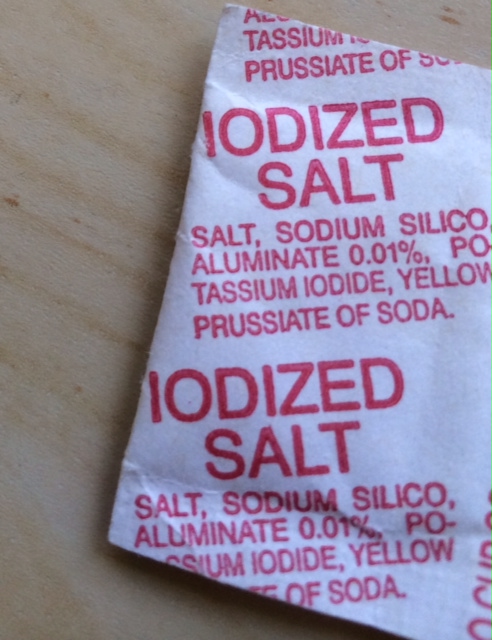Being the nutritionist I am, I read all food labels. Once in a while there is one that really stumps me. This time, it was my recent single-serving salad purchase from the grocery store to-go department came with a pre-wrapped package that included a fork,  knife, napkin, a packet of pepper and a packet of iodized salt. Here’s what the salt packet contained on its list of ingredients:
knife, napkin, a packet of pepper and a packet of iodized salt. Here’s what the salt packet contained on its list of ingredients:
First, the good stuff (sort of):
salt: This surprisingly un-specific word should be listed as the first and only ingredient in table salt. What kind of salt? Am I to assume it’s sodium chloride? I can only hope it is, as this is the safest, tastiest sodium compound. I’d rather it not be calcium chloride (road salt, which is not f0od-grade), but we don’ t know here because the salt packaging company has not told us! In chemistry, “salt” does not automatically imply “sodium”. For example, potassium chloride is technically a salt that happens to taste like sodium chloride, but has a much lower margin of safety. And, things get dangerous when the wrong sodium is used. (For instance, sodium hydroxide is a highly caustic and poisonous compound used to clear clogged drains. ) Eek! I am actually surprised this lack of specificity has flown under the radar of the Canadian Food Inspection Agency, who will not, understandably, allow the word “carbohydrate” to be used to hide the type of sugar or starch used in a food product.
potassium iodide: Don’t panic about this one. This compound is one of the safest ways to provide two essential minerals: potassium and iodine. You will find it in most multi-vitamin-mineral products, too. Since its inception as an additive to table salt in the mid-twentieth century, iodized table salt means goitre (a disease of the thyroid gland) and cretinism (mental retardation in children) has nearly eradicated these diseases from western countries. Verdict: I approve.
Now, the bad news. If any of the following additives are in your table salt, relegate it to the laundry room and use it as an abrasive sink scrub instead.
yellow prussiate of soda: It’s also known as E 535 and by its chemical name: sodium ferrocyanide. You don’t have to be a chemist to see that this compound contains cyanide—the poison used by many fictitious murders! So why it it in my table salt? As it turns out yellow prussiate of soda kills two birds with one stone. Despite its name, it isn’t there to turn grey salt into yellow salt. Instead, it acts as a bleaching agent, turning grey salt into the white salt that westerners have come to associate with purity. Secondly, this additive also doubles as a flow agent. Without it, presumably your salt shaker would get clogged up. Recommendation: Avoid this unnecessary ingredient.
sodium silico-aluminate: Also known as E554, this additive is used to prevent caking and clumping. Remember, aluminum is NOT an essential mineral and in fact, the vast majority of chemists will agree it is a toxic metal for the human body. Less of a health concern is silica, a major element in sand and glass and possibly an essential mineral (silicon). Verdict? I’d avoid E554.
And that is what my packet of salt contained. The best way to avoid unnecessary and potentially harmful food additives in your salt is to buy sea salt. Although there are many varieties of sea salt—pink Himalayan sea salt being one of my favourites—the common thread is that they contain NO additives—not even iodine. But if you eat any processed foods–that is, canned, frozen, boxed or otherwise pre-packaged edibles—have no fear. They will give you more iodized table salt than you bargained for.
